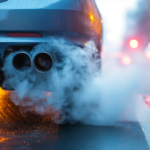Learn how to properly maintain your car’s exhaust system to keep it running smoothly and efficiently. In this article, we’ll guide you through simple steps to check for leaks, clean carbon buildup, inspect and replace components, lubricate connections, and ensure proper mounting. Regular maintenance and inspections are essential for a long-lasting exhaust system. Follow these tips and keep your car in top shape.
Checking for Exhaust Leaks
To properly maintain your car’s exhaust system, you should regularly check for any exhaust leaks. These leaks can occur at any point in your exhaust system, from the manifold to the tailpipe. One way to identify a potential leak is by listening for a hissing or popping sound coming from the engine or exhaust. Additionally, you may notice a strong smell of exhaust fumes inside the car or see black soot around the exhaust pipes. If you suspect a leak, it is important to address it promptly as exhaust leaks can pose serious health risks and can also affect the performance and fuel efficiency of your car. You can visually inspect the exhaust system for any visible signs of damage or corrosion. If you are unsure or need assistance, it is recommended to take your car to a professional mechanic for further inspection and repair.
Regular Cleaning and Removal of Carbon Buildup
You should regularly clean and remove carbon buildup from your car’s exhaust system in order to maintain its optimal performance. Over time, carbon deposits can accumulate inside the exhaust system, obstructing the flow of exhaust gases and reducing the efficiency of your vehicle. One method of cleaning is to use a high-quality carbon cleaner specifically designed for exhaust systems. This cleaner can help dissolve and remove the carbon buildup, restoring the proper flow of exhaust gases. Before applying the cleaner, make sure to read and follow the instructions carefully. It is important to wear protective gloves and work in a well-ventilated area. Regularly cleaning and removing carbon buildup from your car’s exhaust system will not only help maintain its performance but also extend its lifespan.
Inspecting and Replacing Exhaust Components
Now let’s talk about inspecting and replacing the components of your car’s exhaust system. As a car owner, it’s important for you to be aware of the signs of exhaust damage, such as rust or holes, as they can affect the performance of your vehicle. Regular maintenance, such as checking and tightening connections, can help prolong the life of your exhaust components, but there may come a time when you’ll need to replace them.
Signs of Exhaust Damage
What are some common signs of exhaust damage that require inspecting and replacing exhaust components in your car? There are a few key signs to look out for. Firstly, if you notice an increase in engine noise, especially a loud roaring or rumbling sound, it could indicate a problem with your exhaust system. Another sign is a decrease in fuel efficiency, as a damaged exhaust can cause your car to burn more fuel than necessary. Additionally, if you see any visible signs of damage, such as holes or rust on the exhaust pipes, it’s important to have them inspected and replaced. Finally, if you smell a strong odor of exhaust fumes inside the car, it could mean that there is a leak in the system that needs to be addressed immediately. Keep an eye out for these signs to ensure the proper functioning of your car’s exhaust system.
Proper Component Maintenance
How often should you inspect and replace the exhaust components of your car’s exhaust system? Regular inspections are important to ensure the optimal functioning of your exhaust system. It is recommended to inspect the exhaust components at least once a year or every 12,000 miles, whichever comes first. However, if you notice any signs of damage or abnormal noises, it is essential to inspect the system immediately. During the inspection, pay close attention to the exhaust manifold, catalytic converter, muffler, and pipes for any signs of rust, cracks, or leaks. Additionally, check the rubber hangers and brackets that hold the components in place. If any components show signs of damage, it is crucial to replace them promptly to prevent further issues and maintain the efficiency of your exhaust system.
When to Replace
You should regularly inspect and replace the exhaust components of your car’s exhaust system to ensure optimal performance and prevent potential issues. Over time, the exhaust system can deteriorate due to factors such as corrosion, wear and tear, and damage from road debris. It is important to inspect the exhaust components regularly for any signs of damage or excessive wear. Look for rust, cracks, or loose connections in the exhaust pipes, muffler, and catalytic converter. Pay attention to any strange noises, such as rattling or hissing, as they could indicate a problem with the exhaust system. If you notice any issues during your inspection, it is crucial to replace the damaged components immediately. Ignoring these problems can lead to reduced fuel efficiency, increased emissions, and even engine damage. By staying proactive and replacing worn-out parts, you can ensure your car’s exhaust system functions properly and keeps you on the road safely.
Properly Lubricating Exhaust System Connections
Now let’s talk about how to properly lubricate your car’s exhaust system connections. Lubrication is essential for maintaining the connections and preventing them from rusting or becoming loose over time. There are different types of lubricants you can use, such as anti-seize compounds or high-temperature grease, depending on the specific connections. Make sure to lubricate them regularly, following the manufacturer’s recommendations, to ensure optimal performance and longevity of your exhaust system.
Importance of Lubrication
To ensure the longevity of your car’s exhaust system, it is important to properly lubricate the connections. Lubrication plays a crucial role in maintaining the performance and functionality of your exhaust system. By applying lubricant to the connections, you can prevent corrosion and ensure a tight seal, which helps to minimize the risk of exhaust leaks. Proper lubrication also helps to reduce friction between the components, allowing them to move smoothly and freely. This not only improves the overall efficiency of the exhaust system but also reduces the strain on the connections, preventing them from wearing out prematurely. Regularly lubricating the connections is a simple yet effective way to protect your exhaust system and prolong its lifespan.
Lubricant Types and Options
When lubricating the connections of your car’s exhaust system, it is important to consider different types and options of lubricant to ensure proper maintenance. There are various lubricants available in the market that can be used for this purpose. One option is a high-temperature grease, which is specifically designed to withstand the heat generated by the exhaust system. This type of lubricant provides excellent protection against corrosion and helps to reduce friction between the connections. Another option is an anti-seize compound, which is ideal for preventing the connections from seizing or getting stuck together. This compound contains special additives that create a protective barrier and make it easier to disassemble the connections in the future. It is important to choose the right lubricant for your car’s exhaust system to ensure longevity and optimal performance.
Frequency of Lubrication
You should lubricate the connections of your car’s exhaust system at least once a year to ensure proper maintenance. Regular lubrication helps to prevent rust and corrosion, as well as make it easier to remove and replace components when necessary. The exhaust system is subjected to high temperatures and vibrations, which can cause the connections to loosen over time. By applying lubricant to the connections, you can reduce friction and ensure a tight seal. This will help to maintain the efficiency and performance of your exhaust system, as well as prevent any potential exhaust leaks. When lubricating the connections, make sure to use a high-temperature lubricant that is specifically designed for automotive exhaust systems. Regular lubrication will help prolong the life of your exhaust system and save you from costly repairs in the long run.
Ensuring Proper Exhaust System Mounting
Securing your car’s exhaust system in its proper place is crucial for ensuring optimal performance and minimizing potential damage. The exhaust system is responsible for carrying harmful gases away from the engine and reducing noise, so it needs to be securely mounted to prevent any leaks or vibrations. To ensure proper mounting, regularly inspect the exhaust system for any signs of damage or looseness. Check the exhaust hangers, brackets, and clamps for any wear and tear, and replace them if necessary. Use a jack stand to support the exhaust system while you work on it, and make sure all connections are tight and secure. By taking the time to properly mount your car’s exhaust system, you can avoid costly repairs and keep your vehicle running smoothly.
Performing Regular Maintenance and Inspections
To ensure the optimal performance of your car’s exhaust system, regularly inspect and perform maintenance on it. By doing so, you can identify any potential issues early on and prevent major problems from occurring. Start by visually inspecting the exhaust system to check for any signs of damage, such as rust or leaks. Additionally, listen for any unusual noises coming from the exhaust system, as this could indicate a problem. Regularly clean the exhaust system to remove any dirt or debris that may have accumulated. It is also important to check the exhaust system’s mounting brackets and hangers to ensure they are secure and not worn out. Finally, schedule regular visits to a professional mechanic to have your exhaust system inspected and serviced properly. Remember, regular maintenance and inspections will help prolong the life of your car’s exhaust system and keep it running smoothly.

Lucas is an experienced vehicle technician with hands-on knowledge of almost every car brand available. Throughout his career, Lucas has worked on a wide range of vehicles, including domestic and foreign models, sports cars, trucks, and SUVs.





